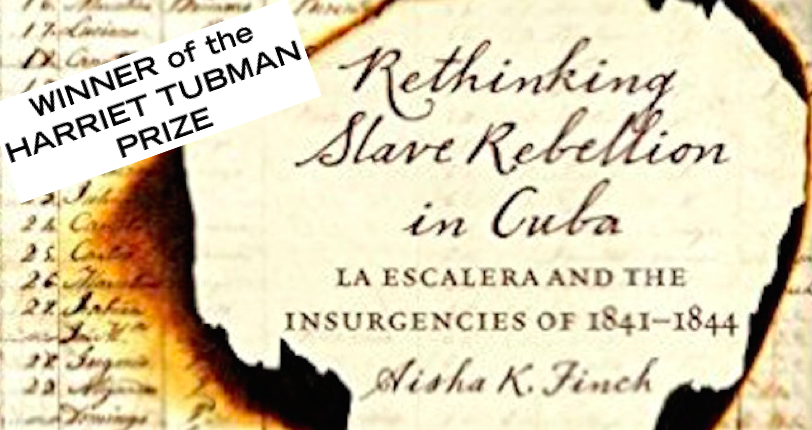In Rethinking Slave Rebellion in Cuba: La Escalera and the Insurgencies of 1841-1844 (University of North Carolina Press, 2015), Aisha K. Finch asserts that “rural slaves of African descent helped organize and lead one of Cuba’s most memorable resistance struggles.” (2) La Escalera refers to a planned slave uprising that Spanish colonial authorities in Cuba uncovered in 1844. The event led to a period of unprecedented interrogation and punishment of enslaved people. The conspiracy and its subsequent unveiling received the name La Escalera for a common form of torture which involved tying suspected insurgents facedown to a ladder [escalera] and beating them.
Finch’s main argument is simple, but revolutionary. For decades after La Escalera, scholars of Cuban slavery assumed that colonial authorities had massively overblown the conspiracy they uncovered. Rather than a response to a planned slave uprising, they argued, La Escalera was a cynical excuse for the state to expand and intensify its control of black bodies at a time when the institution of slavery was facing attack in the Western world. But using the testimonies of enslaved and free African-descended people whom colonial authorities interrogated, Finch demonstrates that the conspiracy Cuba so feared was a reality—imagined in 1841 and carried out partially with two uprisings in 1843.
In some parts of western Cuba in the mid-nineteenth century, over three-fourths of the population was enslaved. At the same time, Cuba had the largest free black population in the Americas, and many of these free people of color lived in rural areas alongside their enslaved counterparts. Urban people of color chafed under colonial laws limiting their access to the upper echelons of society, while enslaved rural people performed backbreaking work. All of these factors made Cuba ripe for a slave insurgency. The Bemba rebellion in March of 1843, for instance, involved some 500 rebels; and the Trirunvirato uprising in November involved 100. It was in December of that year that colonial authorities began to unravel the threads of the larger planned insurgency known as La Escalera.
Throughout the text, Finch challenges assumptions that have dictated previous studies of rebellions and insurgencies. For example, La Escalera did not have one all-powerful charismatic leader. Finch counted over 100 rural leaders across dozens of plantations who confessed to planning the uprisings. Drawing on their national connections—many of the Africans who entered Cuba in the 1830s hailed from the Lucumí nation in West Africa—and the shared experience of the Middle Passage, people of color across rural western Cuba conspired. They communicated with each other through enslaved skilled workers like domestic servants, coachmen, and mechanics who traveled from plantation to plantation with their masters or alone. They utilized what Finch calls “rival geographies” of rural western Cuba—the hinterlands between plantations and plantations’ proximity to each other—to plan simultaneous uprisings. In fact, Finch’s narration of the 1843 uprisings and the many small conspiracies that the colonial investigation uncovered reveal a decentralized but widespread movement. Moving away from the identification of one leader “shifts one’s attention…to exploring the many groups of local organizers scattered across the western regions whose proliferation and coordination proved critical to the dissemination of insurgent designs” (171).
Finch also challenges scholarly understandings of women’s roles in insurgencies, and the gendered nature of rebellion. Enslaved and freed women hosted planning sessions in their kitchens and living spaces; kept their plans a secret; and became the symbolic queens of insurgencies on specific plantations. As such, Finch highlights the emotional and psychic labor of rebellion that enslaved and freed African-descended women performed. The use of kitchens and female-owned homes to discuss and plan insurgency, she contends, “illustrates what feminist scholars have long argued, that the household is inherently a site of political struggle, subjectivity and negotiation” (124). Ultimately, Finch challenges her readers to consider how domestic spaces and the acts of nurturing or harboring secrets can be understood as rebellious and resistant.
Despite testimonial evidence from enslaved people themselves, scholarly skepticism in the last two centuries rendered the widespread slave conspiracy an unlikely event. Finch, however, chooses to believe the enslaved, and bases her analysis of La Escalera on thousands of pages of testimony from suspected conspiracy participants. She brings the world of enslaved and freed Cubans into view by tracing their travels from West Africa to Cuba and by laying out the physical geography of the world they inhabited. Often it seems there are infinite sides to every story about Cuba—who to believe is and will remain a vital question in Cuban politics and popular culture. Ultimately, Rethinking Slave Rebellion in Cuba is essential reading for all those invested in studies of slavery, of black political thought, and of feminism.
Rethinking Slave Rebellion in Cuba
La Escalera and the Insurgencies of 1841-1844
Aisha K. Finch
316 pp., 6.125 x 9.25, 5 halftones, notes, bibl., index
Envisioning Cuba
ISBN 978-1-4696-2234-7
Published: June 2015


